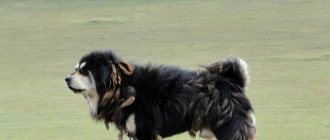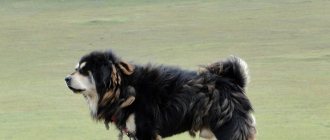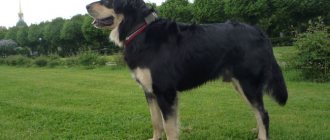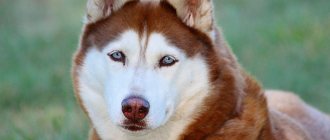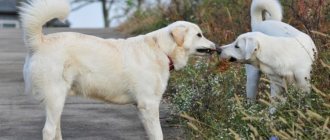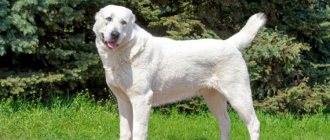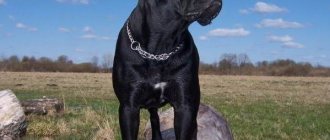From the history of the breed
The exact origin of Mongolian Shepherds is unknown. But researchers suggest that the history of this breed goes back almost 15 thousand years. According to legend, in ancient times a mighty hunter came down from the mountains. He was accompanied by a huge dog, matching his owner, fierce and unsociable. She became the progenitor of modern bankhars. Dog handlers believe that the blood of Tibetan mastiffs and Great Danes flows in the veins of the modern Mongolian Shepherd Dog.
The breed developed naturally; selection did not affect it. In their homeland, dogs were used as guard and herding dogs. They can work at temperatures from minus 40 to plus 40 degrees, without fear of dust storms or snow whirlwinds. Banhar is a wolfhound, because domestic animals first of all had to be protected from predators.
It is known that since the 30s of the 20th century, bankhars began to be involved in security and investigative service in the NKVD. During World War II, the number of shepherd dogs declined sharply (as in many other breeds), they were on the verge of extinction. But since the 90s of the last century, enthusiasts have taken up their restoration. Now Banhars are bred in nurseries, and the situation in the breed looks much better, but they are still far from world fame and recognition.
The breed is not recognized by cynological organizations largely due to its small numbers. But in Mongolia, exhibitions are held where the exterior and performance qualities of bankhars are assessed.
Bankhars are starting to gain popularity outside of Mongolia
The winning shepherd dogs are awarded a handmade cup and medals in the form of the seal of Genghis Khan, which once again emphasizes the reverent attitude of the people towards these dogs.
Puppies
The Mongols have unusual methods for choosing a puppy. The entire civilized world, having decided to get a dog, goes to the kennel. Buryats go to the shaman. He points to the side where the small bankhar is waiting for its owner.
The average life expectancy is 23 years, which indicates the excellent health of this breed.
The pet is chosen based on the color of its palate. Black is good, a brave dog will grow up. It is believed that the future guard of the family must climb through the horse's stirrup. The puppy is literally pushed through it. The baby’s calm behavior at this moment is a sign of a stable psyche.
Everything is simpler in Russia. Puppies are purchased from a nursery that specializes in breeding the breed. You can adopt your little pet at the age of three months.
Description of the breed
Since the Mongolian Shepherd has not received recognition from cynological organizations, it does not have an official breed standard. But there are still signs of what a real bankhar should look like, how to behave towards the owner and other people, what qualities it should have.
Table: features of the appearance of the Mongolian Shepherd
| Criterion | Description |
| Head | The skull is massive with a wide forehead. The muzzle is large, wide, and does not taper towards the nose. The transition from forehead to muzzle is smooth. The frontal groove is deep. The nose is triangular and large. |
| Eyes | Wide set, deep set. |
| Ears | Triangular in shape, hanging, covered with soft wool. Pressed tightly to the head. |
| Torso | Powerful with pronounced withers. The stomach is tucked. |
| Tail | Set on high. Covered with long hair. In a calm state it hangs like a log, in an excited state it is thrown over its back. |
| Limbs | Muscular and massive. The paws are very large and powerful. Long hair between toes. |
| Wool | Medium length - up to 10 cm. In the area of the withers, hips it is longer, forms a fluffy collar and pants. The down is thick and soft. |
| Color |
|
| Height |
|
| Weight | from 70 kg |
Bankhar can grow very large and weigh almost a hundredweight
Character of Mongolian Shepherds
The character of the Banhars is phlegmatic, self-possessed, and non-conflicting. Unsociability and distrust of strangers are innate qualities.
Any stranger is perceived by Mongolian Shepherds with caution, but without aggression. Next, the dog evaluates the owner’s behavior towards the stranger and his own. Regardless of the conclusions the dog comes to, he will not immediately rush at a suspicious person, but he will show his attitude by growling, which can intensify if the stranger does not change his actions. When all warnings, in the opinion of the bankhar, have been exhausted, the wolfhound proceeds to decisive action. He rushes at the aggressor, knocks him to the ground and growls, lowering his muzzle to the enemy’s face, until the owner approaches.
Usually the menacing appearance and size of a shepherd dog is enough to understand that jokes with this dog can end badly.
Since ancient times, bankhars have been used to protect the herd, home and property of the owner. Most often, there is no need to teach them this; the qualities of a good watchman are passed on with mother’s milk.
Attitude towards other animals and children
Bankhars are loyal to other dogs because they work as a team. Showdowns can occur, especially between male dogs, so when raising a dog, close attention is paid to this aspect.
Bankhars can take patronage and patronage over their smaller brothers. Cats and rodents are not considered worthy of attention, but the shepherd dog will not tolerate familiarity from them either.
The Mongolian Shepherd gets along well with children, but will not become a nanny for them. In addition, children should not be left unattended near the bankhar. He may not only accidentally push the child, but also cannot tolerate the squeezing. The dog plays with pleasure with older children, because he is very active by nature.
The Mongolian wolfhound is immensely devoted to its family. He won’t show his feelings every minute, but he will definitely be affectionate when the opportunity arises.
Video: features of the Bankhar breed
Features and character
A unique breed of dog. The appearance, character, customs associated with purchasing a puppy, there is nothing similar in any other country.
The hair of the Mongolian wolfhound is woven into dreadlocks. In the neck and head area, on the tail, on the stomach. Mongolian dog breeders do not do this on purpose; the fur gets into tangles on its own. This does not indicate that the dogs are poorly cared for. Such “dreadlocks” are a good shield when fighting a wolf. The beast will not be able to injure the formidable bankhar.
True Mongolian Shepherds live on the street. Owners love their dogs without restricting their freedom. In Buryatia, it is customary to treat the breed with respect. It is forbidden to offend Mongolian dogs or use physical force against them. It is unlikely that a person in his right mind would dare to challenge a pet that weighs a good hundredweight.
Banhars are described as ferocious and formidable dogs. A huge monster, eager to kill any stranger that gets in its way. These are fantasies, Buryat Shepherd Dogs are completely different. They are unsociable and can hardly tolerate strangers. But they don’t rush at them without reason. If a stranger behaves aggressively, the dog will warn him with a quiet growl. Doesn't work - the growling will become louder. Again the warning is not understood, the dog will repeat it very loudly and very threateningly. If after this the offender does not realize that there is no need to get into trouble, he will be left to blame.
Dreadlocks help the dog protect himself from enemy bites
Mongolian four-legged guards attack quickly and immediately knock the person to the ground. After that, they press him down, placing their paws on his chest, and growl quietly, not taking their eyes off the aggressor’s face. This continues until the dog's owner comes and takes him on a leash.
Banhar is a freedom-loving breed. But one can write poems about his devotion. A reliable guard, a faithful companion and a shepherd who can be trusted with the flock. Not every person can perform herding duties as thoroughly as a big, shaggy dog can.
The cost of a show pet in Russia is high. In Mongolia, it is not customary to sell dogs. It is believed that such a dog will grow up worthless and will bring a lot of grief to its owner. Khotosho is given in exchange for a silk scarf, or a piece of silk fabric.
IMPORTANT! The Mongolian Shepherd is a large dog used to guard livestock and human habitation.
Attitude towards people, children and other pets
Banhar looks scary. The character is not as formidable as the exterior. For all its courage and determination, this dog is loyal to children.
She will not serve as a good nanny; her working qualities do not provide for this. He will allow you to play with himself, and will be patient with minor children’s pranks.
He doesn't like strangers, but he tolerates them. If they behave appropriately.
Mongolian Shepherds have excellent guarding qualities.
Gets along well with other dogs. Without this, it is impossible to live in a pack. Aboriginal wolfhounds “work” together. Showdowns are not welcomed by the owner. Therefore, dogs are trained from childhood.
How to choose a puppy
In the homeland of the Mongolian Shepherd, many traditions are associated with the choice of puppies. To this day they do this, guided by the knowledge received from the older generation, and even turn to shamans for help.
Puppies with a white spot on their chin are believed to bring good luck and wealth to their owner.
One way to test a dog's performance is to grab the puppy by the tail and lift it up. He must bend, but at the same time remain silent. They leave the whining and squirming baby - he will not make a reliable assistant. There is another ancient sign - they look into the puppy’s mouth, paying attention to the upper ribbed palate; there should be at least 9 stripes on it.
To a real dog handler, all these signs may seem funny, but the nomads themselves only use them.
It is customary to adopt a puppy at a very young age, approximately one month old. In order for him to grow into a good shepherd and guard, he is passed through a stirrup. If the puppy is older, he simply will not fit into it.
Price
Nomads do not sell their dogs - this is considered unacceptable, a bad omen. They can only be exchanged for some kind of gift, for example, a silk scarf.
Due to the growing popularity of the breed, private individuals are beginning to breed it. You can buy a puppy from them at a price of 6 thousand rubles, but this does not guarantee that the dog belongs to the Banhars. In nurseries, the cost of small shepherd dogs starts from 65 thousand, and the upper limit reaches 150 thousand rubles.
Since there is no strict breed standard, it is quite difficult to recognize a Bankhar puppy, so it is preferable to purchase from those breeders who can show the parents of the young.
Kennel Gamayun: Caucasian Shepherd Dogs and Buryat-Mongolian Wolfhounds
Let's get acquainted: the breeding nursery "Prophetic Gamayun", one of the oldest and largest private nurseries in Russia. Today there are about a hundred dogs: Caucasian Shepherd Dogs and Buryat-Mongolian Wolfhounds. Our nursery is not commercial; we are fed not by selling puppies, but by work. It is working dogs that are the key to our – and dogs’ – well-being, our pride and heritage. First, let's define what a working dog is. Contrary to popular belief, a working dog is not a “waste product from the production of champions.” This is, first of all, a THINKING dog - it must be able to navigate in any situation, adapt to any environment. After all, you must admit, a stupid evil beast, like a broken machine or a car without brakes, is dangerous primarily for those who contain or service it. It doesn’t matter whether they are amateur owners or professional dog handlers in a nursery or on site. Therefore, we attach paramount importance to the character and behavior of our students. But besides behavior, a working dog must be healthy and fully comply with the Breed Standard. The correct exterior is the key to the performance and longevity of the animal, because initially the Standards were written with a focus on the useful qualities of dogs. Caucasian Shepherds have always been famous for their unpretentiousness and resilience. These qualities, alas, have almost been lost by modern “show” representatives of the breed. Therefore, in addition to a healthy spirit, dogs must have a healthy body, must be beautiful, just as all savages are beautiful: wolves, lions, leopards - whose grace is fully possessed by Caucasian Shepherd Dogs - aborigines and... ours. Today we are the only owners of representatives of unique old blood lines: “Ukhtomsky”, whose continuation was the AZLK kennel, old Moscow ones - the gene pool of the kennel can easily compete in wealth with the modern population of Caucasian Shepherd Dogs. Do you want to see what Real Caucasian Shepherd Dogs looked like? Then come to us. Our dogs do not need a pharmacy or a veterinary hospital to grow up - they only need good natural feeding and simple mineral supplements - without chondroprotectors. They are hardy, active and live on average 12-14 years, maintaining their working capacity until old age.
Among our dogs there is not a single descendant of Jean-Christ.
The second breed bred in the nursery was the Buryat-Mongolian wolfhound or Khotosho. They are the same “savages” as the Caucasian Shepherd Dogs - unpretentious and hardy - they have qualities that the Caucasians lack - although they are almost entirely focused on the person, the Master. We needed patrol dogs to work on sites. We did not find any good VEOs, and the German Shepherds turned out to be too gentle and required the constant attention of veterinarians. This is how hotosho appeared in our nursery. Cheerful and cheerful, completely non-offensive and trainable, easily “fitting” into any proposed conditions, these dogs quickly won the sympathy of the most desperate skeptics who had the opportunity to work with them. They are bodyguards and nannies, security guards and companions, and simply individuals, “pleasant in all respects.”
We don't show our dogs often, and if we do, it's usually at major shows. However, among them there are enough titled ones, from Federation Champions to Champions of “Eurasia” - the largest International exhibition in Russia. We even have a World Champion!
Keeping a Mongolian Shepherd
The Mongolian Shepherd is a freedom-loving dog. Working individuals spend the entire day in the wild, herding the herd or helping the owner in other ways. Nomads do not set up booths for them; bankhars themselves find a place to rest. These are ideal conditions for keeping this dog. An alternative can only be a private house with a spacious enclosure, but at the same time, the shepherd dog should still be out for a walk or at work most of the day.
The thick undercoat allows the bankhar not to be afraid of frost
Keeping a bankhar in an apartment will not have the best effect on his condition - physical and mental. Despite its rather large size, it is an energetic dog that needs a lot of space. It is also unclear why someone would decide to keep this pet in rooms. After all, he is not the best companion, and this dog’s character cannot be a piece of furniture.
Features of care
The Mongolian Shepherd does not require any care that is different from other dogs. She needs:
- wipe your eyes daily;
- Clean your ears weekly with a soft cloth and inspect them for inflammation;
- comb at least once a week, and during the molting period - every other day.
Nomads, by tradition, do not fight tangles in the wool of bankhars; in ancient times, matted wool protected the dog from the teeth of the wolf
Only breeders groom bankhars. Nomads do not touch their fur, which is why it quickly becomes tangled on the collar and pants. This is not due to neglect of the dog, but according to tradition. When the dog entered into a fight with the wolf, he could not bite through the matted fur, so it acted as protection.
Your shepherd's teeth should be checked and cleaned once a week. But one should be accustomed to this procedure from childhood, otherwise the bankhar will regard this procedure as an encroachment on freedom. In any case, dental treats should be added to the diet, for example, special bones made from dry veins, which will mechanically clean the teeth of plaque.
The Mongolian Shepherd is fed twice a day. The basis of her diet should be meat. Boiled cereals and vegetables are added to it. Give fermented milk products and eggs no more than 2 times a week. It is completely acceptable to feed the bankhar with industrial products, but you will have to choose those that belong to the premium class and higher. Economy class food will not provide her with the necessary balance of nutrients, which will quickly affect the condition of the coat and motor activity.
The bankhar is fed at least 1 hour before work and immediately upon returning home. The veterinarian will help you calculate the portion size, but if the dog spends his day actively, then there is no need to be afraid that he will eat more than he should. You need to monitor your pet and feed based on its needs.
If a dog lives in a city, it can only be walked on a leash and with a muzzle.
Maintenance, care and feeding
Primitive (aboriginal) dogs are not whimsical. At home, they are kept on the street, fed raw meat, and forgotten about combing and bathing.
In Russia everything is different. Representatives of the breed need minimal amenities:
- spacious indoor enclosure;
- brushing several times a week;
- feeding with natural food or feed;
- regular walks and physical activity.
Keeping an animal is not as difficult as it might seem. Regular vaccinations and examinations by a veterinarian are an additional point in caring for your pet.
IMPORTANT!!! Mongolian wolfhounds are not prone to disease and live a very long time.
Bankhar health
Many thousands of years of natural selection have awarded the bankhar with very good health. The dogs do not get sick with anything, and even hip dysplasia - the scourge of large breeds - has bypassed them. But breeders are required to vaccinate their dogs. It is advisable that the owner continue vaccination on schedule - some infections not only affect dogs, but are also dangerous to people (for example, rabies).
If your dog was not vaccinated as a child, you can start vaccination at any time. The veterinarian will develop an individual schedule that will need to be followed.
There is evidence that bankhars live up to 23 years. This only confirms the good health of these dogs.
Education and training
Like any large dog, the Bankhar needs training. But raising a puppy begins with its first steps in the owner’s house. The person must become an indisputable authority for the shepherd. You should consistently adhere to your requirements. Among nomads, young animals usually learn by looking at the behavior of older dogs, but if the puppy grows up alone, then it is better to go through a general training course with him.
If puppies grow up with adult dogs, they themselves master the wisdom of protection
Cruel methods of education are not used against bankhar. Physical violence fundamentally spoils the dog’s character: it becomes either cowardly or evil. In both cases, he will no longer be an assistant, and there will be no point in keeping such a dog. Therefore, the owner must be strict, but restrained and patient.
